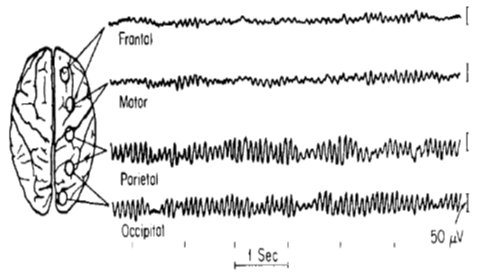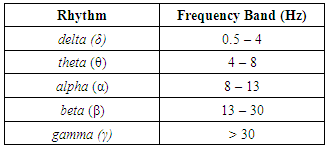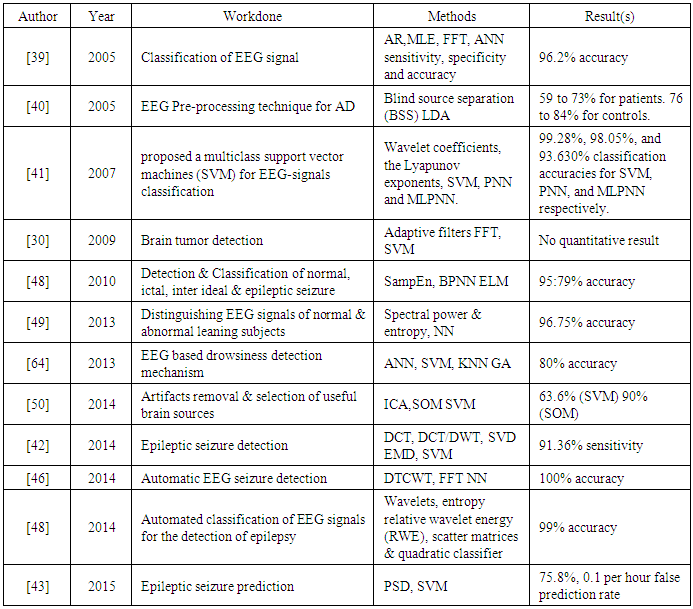| [1] | Luis F. N. and Jaime G. (2012), “Brain Computer Interfaces, a Review”, Sensors, 12, Pp: 1211 1279; doi:10.3390/s120201211, ISSN 1424-8220, www.mdpi.com/journal/sensors. |
| [2] | Wolpaw J R, Birbaumer N, Heetderkd W J, McFarland D J, Peckham P H, Schalk G, Donchin E, Quatrono L A, Robinson C J, Vaughan T M. (2000), “Brain Computer Interface Technology: a Review of the First International Meeting”, IEEE Transactions on Rehabilitation Engineering, Vol. 8, No 2, Pp: 164−173. |
| [3] | Tan, D.S. and Nijholt, A., (2010), “Brain Computer Interfaces: Applying our Minds to Human Computer Interaction”, 1st ed Springer-Verlag, London. |
| [4] | Alonso-valerdi, L. M., Salido-ruiz, R. A. and Ramirez-mendoza, R. A. (2015), "Motor Imagery Based Brain Computer Interfaces: An Emerging Technology to Rehabilitate Motor Deficits”. Neuropsychologia, 79, Pp: 354–363. |
| [5] | Bi L, Fan X-A, Liu Y. (2013), “EEG-Based Brain-Controlled Mobile Robots: a Survey”, Human-Machine Syst, IEEE Trans, Vol. 43, No. 2, Pp: 161–76. |
| [6] | Birbaumer N., Ghanayim N, Hinterberger T, Iversen I, Kotchoubey B, Kübler A (1999), “A Spelling Device for the Paralysed”, Nature; 398, Pp: 297–8. |
| [7] | Xing-Yu WANG, Jing JIN, Yu ZHANG and Bei WANG (2013), “Brain Control: Human-Computer Integration Control Based on Brain-computer Interface Approach”, Acta Automatica Sinica, Vol. 39, No. 3, 208–221. http://doi.org/10.1016/S1874-1029(13)60023-3. |
| [8] | Hassanien, A.E., Azar, A.T., (2015), “Brain–Computer Interfaces: Current Trends and Applications”, Springer International Publishing, Switzerland. |
| [9] | Lopes da Silva F. H., Gonçalves S. I. and De Munck J. C. (2009), “Electroencephalography (EEG)”, Encyclopedia of neuroscience, Academic Press, pp. 849–855. |
| [10] | Lotte, F., Bougrain, L. and Clerc, M. (2015), “Electroencephalography (EEG)-Based Brain Computer Interfaces”, Wiley Encyclopedia of Electrical and Electronics Engineering, Pp. 44. |
| [11] | Aborisade, D.O, Ojo, J.A., and Amole, A.O. (2014a), “Application of Fuzzy-MLP Model to Ultrasonic Liver Image Classification”, European Scientific Journal April 2014 edition vol.10, No.12 ISSN: 1857 – 7881 (Print) e - ISSN 1857- 7431. |
| [12] | Aborisade, D.O., Ojo, J. A., Amole, A.O, Durodola A.O. (2014b), “Comparative Analysis of Textural Features Derived from GLCM for Ultrasound Liver Image Classification”, International Journal of Computer Trends and Technology (IJCTT) – volume 11 number 6, ISSN: 2231-5381, http://www.ijcttjournal.org. |
| [13] | Ahn, M., and Chan, S. (2015), “Performance Variation in Motor Imagery Brain Computer Interface: A Brief Review”, Journal of Neuroscience Methods, 243, Pp: 103–110. http://doi.org/10.1016/j.jneumeth.2015.01.033. |
| [14] | Analoui M. and Fadava A. M. (2006), “Feature Reduction of Nearest Neighbor Classifiers Using Genetic Algorithm”, World Academy of Science, Engineering and Technology, 17. |
| [15] | Andrea K., Donatella M., Rüdiger R. and Michael T. (2013), “Facing the Challenge: Bringing Brain Computer Interfaces to End-Users”, Artificial Intelligence in Medicine 59, 55– www.elsevier.com/locate/aiim Guest Editorial. |
| [16] | Niedermeyer, E., and Lopes da Silva, F. H. (2004), ‘‘Electroencephalography: Basic principles, Clinical Applications and Related Fields’’, 5th Ed. Lippincott Williams & Wilkins, Philadelphia. |
| [17] | Noshadi S. and Es’haghi S. (2013), “Basic Information about BCI Systems”, Research Journal of Applied Sciences, Engineering and Technology, Vol. 5, No. 11, Pp: 3144-3151, ISSN: 2040-7459; e-ISSN: 2040-7467. |
| [18] | Nunez P. L. and Srinivasan R. (2005), “Electrical Fields of the Brain: The Neurophysics of EEG”, New York: Oxford Univ. Press, 2005. |
| [19] | Menon V. and Crottaz-Herbette S. (2005), “Combined EEG and fMRI Studies of Human Brain Function” International Review of Neurobiology, Vol. 66, 2005, Elsevier Inc. DOI: 10.1016/s0074-7742(05)66010-2 0074-7742/05. |
| [20] | Sanei S. and Chambers J.A (2008), “EEG Signal Processing”, John Wiley & Sons. |
| [21] | Sharanreddy M and Kulkarni P.K. (2011), “Review of Significant Research on EEG based Automated Detection of Epilepsy Seizures and Brain Tumor”, International Journal of Scientific & Engineering Research, Vol. 2, Issue 8, ISSN 2229-5518, http://www .ijser.org. |
| [22] | Rajendra A.U., Vinitha S.S., Swapna G, Roshan J. M. and Jasjit S.S. (2013), “Automated EEG Analysis of Epilepsy: A Review”, Knowledge-Based Systems, Elsevier, 45, Pp: 147–165. |
| [23] | Ramadan, R. A., Refat, S., Elshahed, M. A., and Ali, R. A. (2015), “Basics of Brain Computer Interface”, Intelligent Systems Reference Library 74, Springer International Publishing Switzerland, Pp: 31–51, DOI 10.1007/978-3-319-10978-7_231. |
| [24] | Ramesh S., (1999), “Methods to Improve the Spatial Resolution of EEG”, International Journal of Bioelectromagnetism, Vol. 1, No. 1, Pp: 102-111, www.tut.fi/ijbem/. |
| [25] | Bradshaw L. A. and Wikswo J. P. (2001), “Spatial Filter Approach for Evaluation of the Surface Laplacian of the Electroencephalogram and Magnetoencephalogram”, Annals of Biomedical Engineering, Vol. 29, Pp. 202–213, USA. |
| [26] | Tandonnet C., Burle B., Hasbroucq T. and Vidal F. (2005), “Spatial Enhancement of EEG Traces by Surface Laplacian Estimation: Comparison between Local and Global Methods”, Clinical Neurophysiology 116, Pp: 18–24, www.elsevier.com/locate/clinph. |
| [27] | Ferree T. C., Clay M. T. and Tucker D. M. (2001), “The Spatial Resolution of Scalp EEG”, Neurocomputing. |
| [28] | Freeman, W. J., Holmes, M. D., Burke, B. C., and Vanhatalo, S. (2003), “Spatial Spectra of Scalp EEG and EMG from Awake Humans”, Clin. Neurophysiol. 114, 1053–1068. |
| [29] | Indu S. S., Guru K. K. and Santosh K. M. (2012), “Desired EEG Signals For Detecting Brain Tumor Using LMS Algorithm And Feedforward Network” International Journal of Engineering Trends and Technology, Vol. 3 Issue 6, ISSN: 2231-5381, Page 718. |
| [30] | Murugesan M. and Sukanesh R. (2009), “Towards Detection of Brain Tumor in Electroencephalogram Signals using Support Vector Machines”, International Journal of Computer Theory and Engineering, Vol. 1, No. 5, Pp: 1793-8201. |
| [31] | Richard F.T. and Michael M.P. (1974), “Bioelectric Recording Techniques Part Â: Electroencephalography and Human Brain Potentials”, Academic Press, New York and London. |
| [32] | Geva, A. B., and Kerem, D. H. (1998), “Forecasting Generalized Epileptic Seizures from the EEG Signal by Wavelet Analysis and Dynamic Unsupervised Fuzzy Clustering”, IEEE Trans Biomed Eng, Vol. 45, No. 10, Pp: 1205-1216. |
| [33] | Lehmann D (1990), “Brain Electric Microstates and Cognition: The Atoms of Thought”, In: John ER, Vol. Machinery of the Mind, Birkhuser, Boston, pp 209-224. |
| [34] | He B. and Liu Z. (2008), “Multimodal Functional Neuroimaging: Integrating Functional MRI and EEG/MEG” IEEE Reviews in Biomedical Engineering, Vol. 1, 23. |
| [35] | Justin C. S. and José C. P. (2007), “Brain–Machine Interface Engineering”, Morgan & Claypool Publishers series, ISSN 1930-0336 electronic, DOI: 10.2200/S00053ED1V01Y200710BME017. |
| [36] | Wang X Y. (2002), “Automatic Control: Virtuality vs. Reality”, Acta Automatica Sinica, 28 (Suppl): Pp: 77−84. |
| [37] | Deserno T.M. (2011), “Fundamentals of Biomedical Image Processing”, Biological and Medical Physics, Biomedical Engineering, DOI: 10.1007/978-3-642-15816-2 1,c_Springer-Verlag Berlin Heidelberg 2011. |
| [38] | Wu Qui, Feng Xiao, Xin Yang, Xuming Zhang, Ming Yuchi and Mingyue Ding (2011), “Research on Fuzzy Enhancement in the Diagnosis of Liver Tumor from B-mode Ultrasound Images”, I.J. Image, Graphics and Signal Processing, 3, Pp 10 – 16. |
| [39] | Abdulhamit S., Kemal K.M., Ahmet A. and Etem K. (2005), “Neural Network Classification of EEG Signals by using AR With MLE Preprocessing for Epileptic Seizure Detection”, Mathematical and Computational Applications, Vol. 10, No. 1, pp. 57-70. |
| [40] | Cichocki, A., Shishkin, S. L., Musha, T. and Leonowicz, Z. (2005), “EEG Filtering Based on Blind Source Separation (BSS) for Early Detection of Alzheimer’s Disease”, Clinical Neurophysiology, 116, 729–737. http://doi.org/10.1016/j.clinph.2004.09.017. |
| [41] | Inan Gu¨ler and Elif Derya U¨ beyli (2007), “Multiclass Support Vector Machines for EEG-Signals Classification”, IEEE Transactions on Information Technology in Biomedicine, Vol. 11, No. 2. |
| [42] | Mohammad Z.P. and Manoranjan P. (2014), “Epileptic Seizure Detection by Analyzing EEG Signals using Different Transformation Techniques”, Neurocomputing, Elsevier, 145, Pp: 190–200. |
| [43] | Mojtaba B., César A. T., Jalil R. and António D. (2015), “Epileptic Seizure Prediction using Relative Spectral Power Features” Clinical Neurophysiology, Elsevier, 126, 237–248, |
| [44] | Ghanbari, A. A., Broumandnia, A., Navidi, H., and Ahmadi, A. (2012), “Brain Computer Interface with Genetic Algorithm”, International Journal of Information and Communication Technology Research, Vol. 2 No. 1, Pp: 79–86. |
| [45] | Goyal, A., Samadani, A., Guerguerian, A. and Chau, T. (2016), “An Online Three-Class Transcranial Doppler Ultrasound Brain Computer Interface”, Neuroscience Research. http://doi.org/10.1016/j.neures.2015.12.013. |
| [46] | Guangyi C. (2014), “Automatic EEG Seizure Detection using Dual-Tree Complex Wavelet-Fourier features”, Expert Systems with Applications, Elsevier, 41, Pp: 2391–2394. |
| [47] | Halder, S., Käthner, I. and Kübler, A. (2016), “Training Leads to Increased auditory Brain Computer Interface Performance of End-users with Motor Impairments”, Clinical Neurophysiology, 127(2), 1288–1296. http://doi.org/10.1016/j.clinph.2015.08.007. |
| [48] | Song, Y. (2010). A new approach for epileptic seizure detection: sample entropy based feature extraction and extreme learning machine. Journal of Biomedical Science and Engineering, 03(June), 556–567. http://doi.org/10.4236/jbise.2010.36078.; Gajic D, Djurovic Z., Di Gennaro S. and Fredrik G. (2014), “Classification of EEG signals for detection of epileptic seizures based on wavelets and statistical pattern recognition”, Biomedical Engineering: Applications, Basis and Communications, (26), 2, 1450021. http://dx.doi.org/10.4015/S1016237214500215. |
| [49] | Paulraj M.P., Subramaniam, K., Yaccob, S., Hamid, A., and Hema C. R. (2013), “EEG Based Detection of Conductive and Sensorineural Hearing Loss using Artificial Neural Networks”, Journal of Next Generation Information Technology, Vol. 4, No. 3, Pp: 204–212. http://doi.org/10.4156/jnit.vol4.issue3.24. |
| [50] | Wang, Y.K., Chen S.A and. Lin C.T. (2014), “An EEG-Based Brain Computer Interface for Dual Task Driving Detection”, Neurocomputing129 Pp: 85–93. |
| [51] | Leuthardt, E. C., Schalk, G., Wolpaw, J. R., Ojemann, J. G., and Moran, D. W. (2004), “A Brain Computer Interface using Electrocorticographic Signals in Humans”, Journal of Neural Engineering 1, 63–71. http://doi.org/10.1088/1741-2560/1/2/001. |
| [52] | Ashari, R. B., Al-bidewi, I. A. and Kamel, M. I. (2011), “Design and Simulation of Virtual Telephone Keypad Control Based on Brain Computer Interface ( BCI ) with Very High Transfer Rates”, Alexandria Engineering Journal, Vol. 50, No. 1, Pp: 49–56. http://doi.org/10.1016/j.aej.2011.01.008. |
| [53] | Dias, N. S., Mendes, P. M., and Correia, J. H. (2009), “Feature Selection for Brain-Computer Interface”, IFMBE Proceedings 22, pp. 318–321, www.springerlink.com © Springer-Verlag Berlin Heidelberg. |
| [54] | Daly, I., Billinger, M., Laparra-hernández, J., Aloise, F., Lloria, M., Faller, J. Scherer R. and Müller-putz, G. (2013), “On the Control of Brain Computer Interfaces by Users with Cerebral Palsy”, Clinical Neurophysiology, Vol. 124, No. 9, Pp: 1787–1797. |
| [55] | Cao, L., Li, J., Ji, H., and Jiang, C. (2014), “A Hybrid Brain Computer Interface System Based on the Neurophysiological Protocol and Brain-Actuated Switch for Wheelchair Control”, Journal of Neuroscience Methods, 229, Pp: 33–43. |
| [56] | Kuo, C., Knight, J. L., Dressel, C. A., Chiu, A. W. L.,. (2012), “Non-Invasive BCI for the Decoding of Intended Arm Reaching Movement in Prosthetic Limb Control”, American Journal of Biomedical Engineering, Vol. 2, No. 4, Pp: 155–162. |
| [57] | Mousavi, E. A., Maller, J. J., Fitzgerald, P. B., and Lithgow, B. J. (2011), “Biomedical Signal Processing and Control Wavelet Common Spatial Pattern in Asynchronous Offline Brain Computer Interfaces”, Biomedical Signal Processing and Control, Vol. 6 No. 2, Pp: 121–128. http://doi.org/10.1016/j.bspc.2010.08.003. |
| [58] | Li, Y., and Wen, P. P. (2014), “Modified CC-LR Algorithm with Three Diverse Feature Sets for Motor Imagery Tasks Classification in EEG Based Brain Computer Interface”, Computer Methods and Programs in Biomedicine, Vol. 113, No 3, Pp: 767–780. |
| [59] | Lim, J., Lee, J., Hwang, H., Hwan, D., and Im, C. (2015), “Biomedical Signal Processing and Control Development of a Hybrid Mental Spelling System Combining SSVEP-Based Brain Computer Interface and Webcam-Based Eye Tracking”, Biomedical Signal Processing and Control, 21, Pp: 99–104. http://doi.org/10.1016/j.bspc.2015.05.012. |
| [60] | Hsu, W. (2015), “Telematics and Informatics Brain Computer Interface: The Next Frontier of Telemedicine in Human Computer Interaction”, Telematics and Informatics, 32(1), 180–192. http://doi.org/10.1016/j.tele.2014.07.001. |
| [61] | Cecotti, H. (2015), “Toward Shift Invariant Detection of Event-Related Potentials in Non-Invasive Brain Computer Interface”, Pattern Recognition Letters, 66, Pp: 127–134. http://doi.org/10.1016/j.patrec.2015.01.015. |
| [62] | Koo B., Leec H, Nama Y., Kang H., Kohd C., Shind H. and Choi S. (2015), “A Hybrid NIRS-EEG System for Self-paced Brain Computer Interface with Online Motor Imagery”, Journal of Neuroscience Methods, 244, Pp: 26–32. |
| [63] | Kumar, S., and Sahin, F. (2015), “A Framework for a Real Time Intelligent and Interactive Brain Computer Interface”, Computers and Electrical Engineering, 43, Pp: 193–214. http://doi.org/10.1016/j.compeleceng. |
| [64] | Liu, N. H., Chiang, C. Y., & Hsu, H. M. (2013), “Improving driver alertness through music selection using a mobile EEG to detect brainwaves”, Sensors (Basel, Switzerland), 13(7), 8199–8221. http://doi.org/10.3390/s130708199. |
| [65] | Farid A. M, Reda A. E. and Mahmoud E.S. (2016), “A Novel Brain Computer Interface Based on Principle Component Analysis” Procedia Computer Science 82, Pp 49 – 56 www.sciencedirect.com. |
| [66] | Suganthy, M. and Ramamoorthy P. (2012), “Principal Component Analysis Based Feature Extraction, Morphological Edge Detection and Localization for Fast Iris Recognition” Journal of Computer Science Vol. 8 No. 9, Pp: 1428-1433, ISSN 1549-3636. |
| [67] | Matthew T. and Alex P. (1991), “Eigenfaces for Recognition”, Journal of Cognitive Neuroscience, Vol.3, No. 1, Pp: 71-86. |
| [68] | Karhunen J. and Joutsensalo. J. (1995), “Generalization of Principal Component Analysis, Optimization Problems and Neural Networks”, Neural Networks, Vol. 8, No. 4. |
| [69] | Daugman, J.G., (1993), “High Confidence Visual Recognition of Persons by a Test of Statistical Independence”, IEEE Trans. Patt. Anal. Mach. Intell., 15: 1148-1161. |
| [70] | Jutten C., and Herault J., (1991), “Blind Separation of Sources, Part I: an Adaptive Algorithm Based on Neuromimetic Architecture”, Signal Process. 24 Pp: 1–10. |
| [71] | Hyvarinen A. and Oja E. (2000), “Independent Component Analysis: Algorithms and Applications”, Neural Networks Off. J. Int.Neural Network Soc.13, Pp: 411–430. |
| [72] | Kohonen, T. and Somervuo, P (1998), “Self-Organizing Maps of Symbol Strings”, Neurocomputing 21, Pp: 19–30. |
| [73] | Konstantina S.N., Spyretta G., Ioannis A., John S.S., Ioannis V. and Nikolaos N.T. (2011), “Comparison of Multiresolution Features for Texture Classification of Carotid Atherosclerosis from B-mode Ultrasound”, IEEE Transactions on Information Technology in Biomedicine, Vol. 15, No. 1, Pp 130 – 137. |
| [74] | Mark S. N. and Alberto S. A. (2002), “Feature Extraction and Image Processing”, Butterworth-Heinemann, Oxford, ISBN: 0 7506 5078 8. |
| [75] | Menser B. and Muller F. (1999), “Face Detection in Color Images using Principal Component Analysis”, IEE Conference Publication, Vol.2, No. 465, Pp: 620-624. |
| [76] | Mitchell, M., Holland, J.H. and Forrest, S. (1994), “When will a Genetic Algorithm Outperform Hill Climbing”, in Cowan, J.D., Tesauro, G., and Alspector, J. (editors) Advances in Neural Information Processing Systems, Vol.: 6, 1994, Morgan Kaufmann Publishers, ISBN 1558603603, Pp. 51-58. |
| [77] | Rezaei S., Tavakolian K, Nasrabadi A. M., and Setarehdan S. K. (2006), “Different Classification Techniques Considering Brain Computer Interface Applications”, Journal of Neural Engineering, 3:139-144. |
| [78] | Tavakolian K., Vasefi F., Naziripour K. and Rezaei S. (2006), “Mental Task Classification for Brain Computer Interface Applications”, In Proceedings of the Canadian Student Conference on Biomedical Computing, 2006. |
| [79] | Shutao L., Kwok J.T., Zhu H. and Wang Y. (2003), “Texture Classification using Support Vector Machine”, Pattern Recognition, Vol. 36, No. 12, Pp 2883 – 2893. |
| [80] | Laine, A. and Fan, J., (1993), “Texture Classification via Wavelet Pattern Signatures” IEEE Transaction on PAMI, 15 (11) Pp. 1788-1191. |
| [81] | Fukunaga K. (1990), “Introduction to Statistical Pattern Recognition”, Second Edition, Academic Press, USA. |
| [82] | Amit K. (2000), “Artificial intelligence and soft computing: behavioral and cognitive modeling of the human brain”, CRC Press LLC, ISBN 0-8493-1385-6, New York. |
| [83] | Bernhard S.K., Chris J.C., Burges F.G., Partha N., Tomaso Poggio and Vladimir Vapnik (1997) “Comparing Support Vector Machines with Gaussian Kernels to Radial Basis Function Classifiers” IEEE Transaction. Signal Processing. Vol. 45 No. 11. Pp 2758-2765. |
| [84] | Daubechies I. (1988), “Orthonormal Bases of Compactly Support Wavelets”, Communication Pure and Applied Mathematics XLI, Vol. 41, Pp 909-996. |
| [85] | Lu C.S., Chung. P. C. and Chen C. F. (1997), “Unsupervised Texture Segmentation via Wavelet Transform”, Pattern Recognition, Vol. 30, No. 5, Pp 729-742. |
| [86] | Yasser M. Kadah, Aly A. Farag, Jacek M. Zurada, Ahmed M. Badawi and Abou-Bark M. Youssef (1996), “Classification Algorithms for Quantitative Tissue Characterization of Diffuse Liver Disease from Ultrasound Images”, IEEE Transaction on Medical Imaging, Vol. 15, No. 4. |
| [87] | Sujana H., Swarnamani S. and Suresh S. (1996), “Application of Artificial Neural Networks for the Classification of Liver Lesions by Image Texture Parameters”, Ultrasound in Medicine and Biology, Vol. 22. No. 9, Pp. 1177-1181. |
| [88] | Kumar S.S and Moni R.S. (2010), “Diagnosis of Liver Tumor from CT Images Using Fast Discrete Curvelet Transform”. IJCA Special Issue on “Computer Aided Soft Computing Techniques for Imaging and Biomedical Application.” Pp 1-6. |
| [89] | Mitchell, T. M. (1997), ‘Machine Learning’, International Edition, McGraw-Hill Book Co, Singapore, ISBN 0-07-042807-7. |
















 is the window function which ensures that neigbouring points in the target have weights that are similar and its value is 1.0 for y = y*.
is the window function which ensures that neigbouring points in the target have weights that are similar and its value is 1.0 for y = y*. 
 are the scaling coefficients,
are the scaling coefficients,  is a scaling function,
is a scaling function,  are the wavelet coefficients and
are the wavelet coefficients and  is the wavelet function. The scaling and wavelet function can further be express a family of functions as follows
is the wavelet function. The scaling and wavelet function can further be express a family of functions as follows





 Abstract
Abstract Reference
Reference Full-Text PDF
Full-Text PDF Full-text HTML
Full-text HTML

